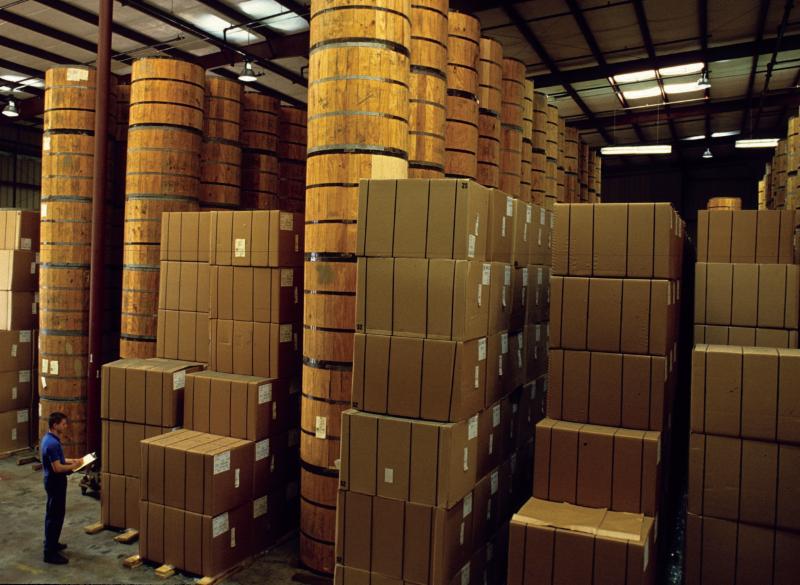| |||||||||||||||
Wednesday, December 19, 2018
Will the short U.S. crops of 2018 lead to aggressive buying?
Sunday, November 25, 2018
THE SMALLEST U.S. BURLEY CROP IN HISTORY?
The burley crop just coming on the market has been projected at 90 million pounds, says Daniel Green, chief operating officer, Burley Stabilization Corporation. The numbers may end up a little higher by the end of the delivery season, but Green says it will not go higher than 100 million lbs. Either volume would be the smallest burley crop since records have been kept.
The shortfall resulted in part from the substantial cutbacks in plantings last spring (20 percent according to USDA), but late-season rains were the big factor. Some fields were drowned out by these rains, and leaf drop was a problem too. NOTE: Burley deliveries will begin in earnest next week.
Despite yield losses, the quality of this burley crop is decent, says Green, similar to the last two crops. "You could call this crop 'low in volume but acceptable in quality'," he says. "But much of the leaf is thin. There isn't a lot of the good-bodied redder styles that buyers are looking for."
Considering the circumstances, the sales season at Big M Warehouse in Wilson, N.C. (all flue-cured), went fairly well, says owner Mann Mullen. "We sold some tobacco for more than $2 a pound," he says. "But the practical top was probably more like $1.88." One big surprise: Some scrap tobacco sold for $.35 to $.75 a pound. And those prices held toward the end, when leaf prices fell off," he says. That was one of several indications that the market has changed its preferences, but Mann can't figure out what the changes are. "What is quality in flue-cured? I used to know but I don't know any more," he says. Mann is very apprehensive about next season, but for whatever it is worth, all tobacco offered at his warehouse found a buyer. There will be one more sale on November 28.
AOI's Farmville (N.C.) plant will no longer process leaf. Alliance One is moving all its U.S. tobacco processing to its Wilson, N.C., facility. AOI's processing operations in Farmville, N.C., will be relocated (tentatively) by the beginning of the 2019 season. Some processing jobs will shift from Farmville to Wilson, and the Farmville facility will be "repurposed" for storage and special projects. But a workforce reduction in Farmville is nevertheless expected. "Consolidating our U.S. tobacco processing operations in Wilson is designed to maximize efficiency and allows us to continue to competitively deliver value-added products and services to our customers," said Pieter Sikkel, c.e.o. of AOI's parent cor-poration Pyxus International. The move was caused in part by new and increased tariffs on U.S. tobacco, declining export demand and the strong U.S. dollar, a statement by the company said.
In other leaf news:
Hot market in Malawi: As reported in the last issue of Tobacco Farmer Newsletter. Malawi's burley market (which ended in August) enjoyed much more sales volume than expected. It has now been learned that part of that excess--roughly 30 million pounds--may have been tobacco from growers in the neighboring countries of Mozambique and Tanzania, indicating the strong market in Malawi late in the season.
Hurricane spares tobacco in Cuba: Hurricane Michael touched Pinar Del Rio, the western end of Cuba and its leading cigar-producing province. But damage to the tobacco crop--which occurred mainly on October 8--was limited and can be managed, said the president of the leading cigarette manufacturer, Justo Luis Fuentes. In the newspaper La Prensa, Fuentes said, "We have the necessary resources to repair the damaged crops." According to preliminary reports, about 60,000 nurseries were lost, along with some planted hectares and 12 tobacco barns. Fortunately, this was very early in the season not much of the crop was in the field.
Mark your calendar: N.C. Tobacco Day, December 6 8:30 a.m.-12 p.m. Johnston County Extension Center, Smithfield, N.C. Lunch will follow the program.
Tuesday, November 6, 2018
FLUE-CURED MARKET COMING TO AN END
|
Monday, October 22, 2018
THE RAINY END OF THE 2018 SEASON

Too much rain in September robbed Kentucky burley of much of its production capacity.
With two record-setting hurricanes wreaking havoc on eastern North Carolina flue-cured and exceptional rains in Kentucky in September, it was a discouraging ending indeed for much of the Tobacco Belt. Among the types:
FLUE-CURED
NORTH CAROLINA--There is still some disagreement about the loss from Hurricanes Florence and Michael, but 100 to 110 million pounds seems to be a realistic estimate. Almost all of that came in the Eastern Belt and most was the result of Florence. But Michael had more of an effect in the Old Belt, where some flue-cured is still being harvested as fast as growers can get it out. "On late-planted tobacco, we saw some late-planted harvested just once, then all the rest was stripped," says Dennis White, owner of the Old Belt Tobacco Sales, which operates a warehouse near Winston-Salem. He is still getting good sales at this warehouse, and all leaf offered has found a home. But the character of the leaf offered now has definitely changed. "Now  it is mostly on the H side. H5K is a grade we see a lot." The price has not gone up substan-tially since the hurri-canes, White says. "It falls in the $1.50 to $1.65 range." The practical top has been around $1.85. But even though demand wasn't extremely strong before the weather crisis, one wonders if all orders will be met.
it is mostly on the H side. H5K is a grade we see a lot." The price has not gone up substan-tially since the hurri-canes, White says. "It falls in the $1.50 to $1.65 range." The practical top has been around $1.85. But even though demand wasn't extremely strong before the weather crisis, one wonders if all orders will be met.
 it is mostly on the H side. H5K is a grade we see a lot." The price has not gone up substan-tially since the hurri-canes, White says. "It falls in the $1.50 to $1.65 range." The practical top has been around $1.85. But even though demand wasn't extremely strong before the weather crisis, one wonders if all orders will be met.
it is mostly on the H side. H5K is a grade we see a lot." The price has not gone up substan-tially since the hurri-canes, White says. "It falls in the $1.50 to $1.65 range." The practical top has been around $1.85. But even though demand wasn't extremely strong before the weather crisis, one wonders if all orders will be met.
VIRGINIA -- Excessive rain occurred in late August and continued in the form of storms in September and October "Assuming we were heading toward a 50- to 52-million-pound flue-crop crop in Virginia, I would guess that we lost 10 to 12 percent of that total," says David Reed, Extension tobacco agronomist. "In the eastern area, the loss is probably in the area of five percent, but might have approached 15 to 20 percent in some areas of Pittsylvania and Halifax Counties." A few growers made their contracted pounds, but most will fall short, Reed says.
SOUTH CAROLINA--Very little tobacco remained in the field in South Carolina when Florence blew through. Area Extension agronomy agent William Hardee estimated for Tobacco Farmer Newsletter earlier that 200 to 400 acres still had leaf to be harvested at that time, almost all of it tip leaf. Overripening ensued and he feared none of it was saved (see TFN, October I, 2018).
BURLEY
KENTUCKY--The burley crop in Kentucky took a significant hit from the rains in September, says Bob Pearce, Kentucky Extension tobacco specialist. "Statewide. I would estimate losses of 20 to 30 percent. In the bluegrass region, the losses may have been up to 40 percent in the bluegrass region." He thinks burley production for Kentucky lost 20 to 30 million pounds and might be down to a total of around 80 million pounds."
TENNESSEE--Burley in Tennessee was not seriously affected by the rains that struck Kentucky late in the season. "There was a small percentage affected. maybe five percent," says Eric Walker, Tennessee Extension tobacco specialist. "Overall, the crop looks pretty good. A small percentage of the tobacco was hit late with significant foliar  leaf spot diseases, mainly frogeye leaf spot and some target spot. Rather than the weather, other factors have significantly reduced the size of the burley crop this year. I expect acreage to be down 35-40 percent from last year, and that may be a little conservative. Estimates of pounds are always hard, but I think we will have somewhere around 12 million pounds."
leaf spot diseases, mainly frogeye leaf spot and some target spot. Rather than the weather, other factors have significantly reduced the size of the burley crop this year. I expect acreage to be down 35-40 percent from last year, and that may be a little conservative. Estimates of pounds are always hard, but I think we will have somewhere around 12 million pounds."
 leaf spot diseases, mainly frogeye leaf spot and some target spot. Rather than the weather, other factors have significantly reduced the size of the burley crop this year. I expect acreage to be down 35-40 percent from last year, and that may be a little conservative. Estimates of pounds are always hard, but I think we will have somewhere around 12 million pounds."
leaf spot diseases, mainly frogeye leaf spot and some target spot. Rather than the weather, other factors have significantly reduced the size of the burley crop this year. I expect acreage to be down 35-40 percent from last year, and that may be a little conservative. Estimates of pounds are always hard, but I think we will have somewhere around 12 million pounds."
OHIO--Uncharacteristic rains in August, Sep-tember and the first half of October left burley tobacco in a "mess" in Southern Ohio. There is still crop in the field. Some farms in Adams County reported around 18 inches of late-season rain, says David Dugan, Ohio Extension Educator. "Several acres were under water as result of heavy rains over the Labor Day weekend. Some producers harvested less than half of their crop as a result. The Gallia County area is probably 60-70 percent harvested--the rest was lost. The quality of what was harvested was impacted, but I am not sure to what extent. I do not have a good estimate for pounds but would think Ohio is looking at a minimum of a 50 percent loss."
DARK
BLACK PATCH--The dark-producing area of western Kentucky and Tennessee perhaps had the best fortune of any of the states in September and October. It avoided the storms that damaged the crop in the bluegrass area. "We still have a good crop," says Andy Bailey, Extension dark tobacco specialist. "There is still maybe 10 percent of the dark fired crop to be harvested yet." He thinks there will be around 56 million pounds of dark fired and around 19 million pounds of dark air cured.
Saturday, October 6, 2018
A REPORT ON WHAT'S LEFT OF THE 2018 CROP
|
Wednesday, September 12, 2018
HOW TO HANDLE THE HURRICANE

Hustling to beat the hurricanes: Workers hustle to get flue-cured leaf in barns in Wake County, N.C. (File photo by Chris Bickers)
|
With Florence bearing down, many of the flue-cured growers along the Atlantic Coast faced intense weather conditions with significant tobacco still in the field. Georgia might dodge the bullet since the path of the storm is expected to pass by it, and most of its crop has been harvested already (95 percent as of September 9, according to USDA). But South Carolina still had 10 percent unharvested, Virginia 35 percent, and in North Carolina, Extension specialist Matthew Vann reckons that 40 to 45 percent of the fields still have enough tobacco in them to be negatively affected by Florence.
 And the effect can be severe, Vann says. "You can expect heavy rains and very strong winds, and that will cause leaf whipping," he says. "It appears that we can expect at least a three-or-four-day wind. With the intensity of the conditions expected, the leaf is going to ripen extremely fast." To make matters worse, it has been coming off fast the last few weeks, and Vann feels most growers are already maxed out on barn space...What to do? Well, in the short term, the goal should be to minimize the leaf you lose as a result of electrical failure during the cure. Grant Ellington, Extension agricultural engineer at N.C. State, provided an excellent set of recommendations a few storms ago. I am going to print it below in hopes it will help you prepare for the worst. And the effect can be severe, Vann says. "You can expect heavy rains and very strong winds, and that will cause leaf whipping," he says. "It appears that we can expect at least a three-or-four-day wind. With the intensity of the conditions expected, the leaf is going to ripen extremely fast." To make matters worse, it has been coming off fast the last few weeks, and Vann feels most growers are already maxed out on barn space...What to do? Well, in the short term, the goal should be to minimize the leaf you lose as a result of electrical failure during the cure. Grant Ellington, Extension agricultural engineer at N.C. State, provided an excellent set of recommendations a few storms ago. I am going to print it below in hopes it will help you prepare for the worst.
Curing Tips
Should adverse weather cause the loss of electrical current to the tobacco curing barn and a backup generator is not available, listed below are some tips that are recommended in order to minimize leaf damage.
For tobacco that is being cured, the damage that might be sustained is related to the stage of cure when the power is lost and the condition of the tobacco when it is loaded into the barn. Tobacco that is in the very early or late stages of curing generally fairs the best when the power is out for extended periods. The following guidelines are useful when generator capacity is limited or not available:
Barn Loading Considerations
BURLEY REPORT:
In East Tennessee, 2018 is beginning to look like a better-than-average season. "We have a good-looking crop," says Don Fowlkes, Agronomy Manager, Burley Stabilization Corporation. "There were the normal seasonal challenges, but now it appears that we have decent weight and the outlook for good quality also." At least half has been harvested and curing has gone well. Growers got a break in the first few weeks of curing. "It has been
 unusually hot the past two or three weeks, but we have had good humidity so the tobacco hasn't cured too fast." Fowlkes has hopes that this crop may have plenty of the reddish color that buyers are looking for. unusually hot the past two or three weeks, but we have had good humidity so the tobacco hasn't cured too fast." Fowlkes has hopes that this crop may have plenty of the reddish color that buyers are looking for.
In Kentucky, a fairly dark color seems on the way too, says Bob Pearce, Kentucky Extension toba-cco specialist. So far, there hasn't been significant flash curing. Like Tennessee, Kentucky has plenty of humidity. Maybe too much. Pearce fears there may be a problem of houseburn. Some Kentuckians got rain from Tropical Storm Gordon, but there hasn't been much rain since Sunday, Pearce says. "But it continues cloudy. We have had no sunshine for some time." More than half the Kentucky burley crop has been harvested, says Pearce. "But not much more."
The September USDA Crop Report was released at noon. Flue-cured tobacco production is expected to total 415 million pounds, the report says, down 10 percent from 2017. Burley tobacco production is expected to total 129 million pounds, down 20 percent from last year. Production projections by type and by state for flue-cured and burley follow.
Note--The only types that (according to USDA) increased in production over 2017 are dark air-cured and Pennsylvania seedleaf, neither of which is used in cigarettes.
To receive the newsletter in your email box, please click on "Join our mailing list" and follow the prompts. For more information, call 919-789 4631 or email cebickers@aol.com.
|
Wednesday, September 5, 2018
AUCTION SALES IMPROVE--A LITTLE
|
Subscribe to:
Posts (Atom)

 2,000 pounds," says Snell. "You can't justify labor and oth-er costs with that low of a yield."
2,000 pounds," says Snell. "You can't justify labor and oth-er costs with that low of a yield."

 were a few cases where leaf that was already harvested in barns or in storage was damaged.
were a few cases where leaf that was already harvested in barns or in storage was damaged.






 quickly turning orange and drying up," says Charles Mitchell, Extension agent. "We are experiencing barn rot and brown stems. Decisions are currently being made whether to continue harvesting or stop." Many Franklin County growers had 50 percent of their crop remaining in the field prior to Florence. In Craven County, unharvested tob-acco and corn left in fields were badly damaged, says Mike Carroll, county Extension agent. "(It is) unlikely to be harvested simply due to excessively wet soils and rapid decay of leaf/kernels."
quickly turning orange and drying up," says Charles Mitchell, Extension agent. "We are experiencing barn rot and brown stems. Decisions are currently being made whether to continue harvesting or stop." Many Franklin County growers had 50 percent of their crop remaining in the field prior to Florence. In Craven County, unharvested tob-acco and corn left in fields were badly damaged, says Mike Carroll, county Extension agent. "(It is) unlikely to be harvested simply due to excessively wet soils and rapid decay of leaf/kernels."
 Kentucky burley was still in the field, said USDA, compared to 10 percent in Tennessee and 42 percent in North Carolina.
Kentucky burley was still in the field, said USDA, compared to 10 percent in Tennessee and 42 percent in North Carolina.








